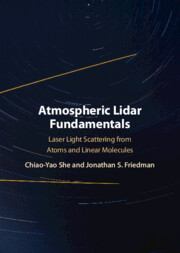Book contents
- Atmospheric Lidar Fundamentals
- Atmospheric Lidar Fundamentals
- Copyright page
- Dedication
- Contents
- Foreword
- Preface
- 1 Introduction
- 2 Classical Light Scattering Theory
- 3 Semiclassical Treatment of Light Absorption and Scattering from Atoms
- 4 Rayleigh and Raman Scattering from Linear Molecules
- 5 Introduction to Lidar Remote Sensing and the Lidar Equation
- 6 Common (Broadband) Lidar Types and Associated Applications
- 7 Lidars for Profiling Aerosol Optical Properties, Atmospheric Temperature and Wind
- 8 Transmitting and Receiving Optics
- Book part
- Index
- References
3 - Semiclassical Treatment of Light Absorption and Scattering from Atoms
Published online by Cambridge University Press: 24 February 2022
- Atmospheric Lidar Fundamentals
- Atmospheric Lidar Fundamentals
- Copyright page
- Dedication
- Contents
- Foreword
- Preface
- 1 Introduction
- 2 Classical Light Scattering Theory
- 3 Semiclassical Treatment of Light Absorption and Scattering from Atoms
- 4 Rayleigh and Raman Scattering from Linear Molecules
- 5 Introduction to Lidar Remote Sensing and the Lidar Equation
- 6 Common (Broadband) Lidar Types and Associated Applications
- 7 Lidars for Profiling Aerosol Optical Properties, Atmospheric Temperature and Wind
- 8 Transmitting and Receiving Optics
- Book part
- Index
- References
Summary
In Chapter 3, we move to a semiclassical treatment (quantum theory) of light absorption and scattering, specifically from atoms. We start with a description of how lidar measures Doppler shift, and the fundamental difference between the measurement when the laser is in resonance with an atomic transition (resonant) and when it is not (nonresonant). We follow with a treatment of quantum polarizability and the resulting absorption cross section, leading to the differential resonance scattering cross section and its contrast with the classical result. After quantum polarizability, we demonstrate the radiation pattern of coherently excited atoms. This takes us to an interpretation of the Hanle Effect. Following these descriptions of the phenomena that impact resonance lidar, we extend our understanding by closing the chapter with an overview of the rudimentary physics of sodium laser guide stars.
Keywords
- Type
- Chapter
- Information
- Atmospheric Lidar FundamentalsLaser Light Scattering from Atoms and Linear Molecules, pp. 17 - 49Publisher: Cambridge University PressPrint publication year: 2022

